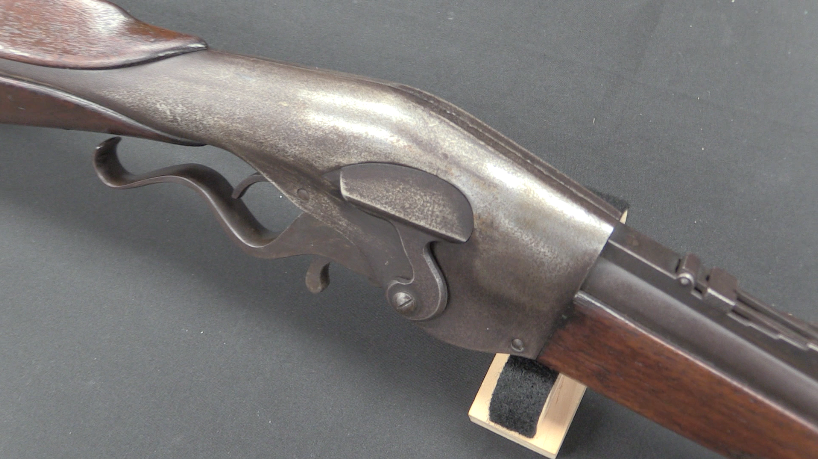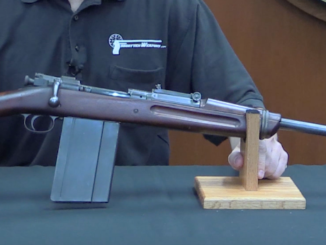The primary sniper rifle used by the United States in World War II was the M1903A4 Springfield, a version of the exisiting 1903A3 with the iron sights removed and replaced with a Weaver 330C scope (adopted by the military as the M73B1). This was a low-power optic, but was centrally mounted on the rifle to avoid and of the windage issues caused by prismatic scopes.
The 1903A4 Springfield was the US’ first truly mass-produced sniper rifle, with more than 28,000 being manufactured during just two years of the war (1943-44). The rifle was taken out of production when the M1C sniper adaptation of the Garand was formally adopted, although production of the M1C would be delayed until the end of the war. The 1903A4 would remain in service after WWII, with later scopes being approved as replacements for the M73B1 (in this video, we will take a look at one equipped with an M84, the optic adopted for the later M1D).
The US Marine Corps, of course, had to be a bit different, and adopted their own sniper rifle variant in 1941, a 1903A1 fitted with an 8 power Unertl scope. These scopes were a tradeoff, being significantly more fragile than the M73B1, but also being much better for long range precision shooting. The USMC, taking much pride in their culture of marksmanship, was happy to make that trade, and the rifles served well throughout the war.




I own a Creedmoor rebuild of an 03A4. Orignal WW2 Remington receiver(03-A3) & bolt – 3.x million – built circa ’43. New Criterion barrel, new stock and reproduction Weaver 330C scope. It can drill tacks at 600 yds. I’ve shot a 191-14X during a CMP Vintage Sniper match (10 @ 300y, 10 @ 600y). As for marking zero – its amazing what white nail polish can do. 😉 A buddy has a Marine 03 sniper version with a Chinese made Unertl (he calls is a “Chi-nertl”). And yes….more fragile than the Weaver. It has issues holding a zero. Having all three in the video would be quite a collection. If someone wants a very good reproduction the Creedmoor 03A4 is a good choice. Retails today for about $1,500. (and no….I don’t work for Creedmoor) Thanks for today’s post.
PS: one of the better known Hollywood images of the 03A4 is the sniper in Saving Private Ryan…..an Army Ranger using a sniper rifle with a Unertl scope.
Funny thing about the repro 03A4 rifles is that they’re often better made than the originals, and not just the barrel. They were simply off the line 03A3 parts slapped together on a drilled and tapped receiver (with different markings) and a scope. They were not carefully assembled for accuracy like the M1941 was. A friend of mine has two completely original 03A4’s that we shoot. The work that was done fitting the stocks to the receivers and barrels was absolutely horrible, though so were many wartime 03A3 stocks. It’s especially apparent when compared to original, not worn stocks from all other eras. The hand fitting on pre-WWI, interwar, and interwar National Match rifles is absolutely beautiful. Even my early WWII Remington stock that I have on my match 03 is quite well done.
On the sliding scope ring models, would the scope slide forward enough to allow use of stripper clips? I wasn’t paying enough attention to notice if Ian mentioned that feature?
No.
A friend has a Remington 40x with a Unertal (forget the model) on it. As long as you remember to reseat the scope between shots, it’ll get the job done at the 1,000 yard line at Perry.
https://s-media-cache-ak0.pinimg.com/564x/9a/df/6b/9adf6bc4d6d844a253892e9a6a008478.jpg
I like the one on the bottom. ^__^ (Unertl mounted on M2.)
I wonder how far the scope wandered off zero with each shot on that M2.
Back in the 1990’s I came across an A3A4 with the original scope on it at a local shop. The shop owner said he could send the scope off to be fixed if I bought the rifle. Unfortunately I could not get the money together in a short enough time frame and I do regret that because I’ll never have such a piece of history.
My father back in the 1950’s built two M1’s. In that same time frame, 1990’s, I got the part to convert one to an M1D.
While I do approve of dedicated sniper rifles, I recommend having a secondary weapon (preferably a carbine or submachinegun) just in case your intended gallery pigeons get within rock throwing distance! Having no iron sights means that the sniper rifle cannot easily engage in a close quarters brawl. Therefore, any good sniper will have someone else keeping a watch on other targets in field. The last thing you want is for someone on the other team to sneak up behind you and stab you in the back!
Did I mess up?
Don’t most sniper teams include a spotter who would normally carry an assault rifle? I think that some snipers, or at least designated marksman types with semi-auto rifles, have carried both optical and red dot sights with quick-disconnect mounts so they could go to one or the other quickly as needed.
McBride in his WWI book on sniping sang the praises of iron sights on sniping rifles, but it was so that he could confirm that the scope was still in line with the bore.
Certainly the USMC, etc. employ a team of snipers, who take turns with the sniping rifle. The spotter carries a conventional 5.56mm rifle and 9mm pistol. Apparently the WWII Japanese often used just a single sniper without a spotter or assistant…
The two man sniping team seems to have originated with the USMC and while it is today widely recognized as the best practice for “true” snipers (as opposed to designated marksmen), it wasn’t always so. Soviet and German snipers often operated alone in WW2, probably on the theory that a single man could stay concealed more easily.
Ian:
You need another clip. Comparing and shooting the USMC 1903 sniper rifle, the M1903A4, the M1C, M1D, and M-40 series sniper rifles. Shooting them at 300, 400, 500 yrds.
In ref to the 3 rifles you compared on the James Julia auction clip. You didn’t talk about the inleting modification to the stock and bent bolt handle, and safety lug.
I’ve built a quasi-scout with an IER Leupold 2.75 power fixed scope mounted on a Soviet 91/59 carbine. It was doing quite well… For about twenty or so shots. Then the recoil sheared the attachment bolt of the scope mount, which has to rely on flimsy “work arounds” of the old metricated Soviet iron sights… Not quite ready for a hunting trip just yet… Iron sights or scopes, sturdiness is a must!